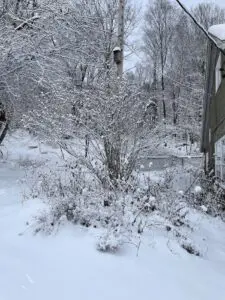2023 was the year that climate change models and forecasts became real to me in the most vivid way: the lack of stability and predictability in weather; the sharp discrepancies between what I thought would happen and what did happen; and the story of water and heat making me feel like I was in a science-fiction movie about trying to live on a planet with weather that made it uninhabitable. I realized there was a vast difference between knowing the planet is warming and experiencing it.

Now that 2023 has been confirmed as the hottest year on record — a record that has been repeatedly shattered since 2000 — it’s difficult to keep absorbing what that means. Yes, the atmosphere is heating faster than scientists anticipated. Yes, extreme weather is more common. Yes, it’s expensive, uncomfortable and deadly, especially for people without money and power. The rest of non-human life — plants and trees, animals and birds — are either the focus of extraordinary conservation measures, or not.
In my own landscape, this meant that I saw many soggy yards and broken trees. I answered many questions about what to plant and when, and why and how to care for it, during unpredictable seasons. After a spring drought, then a summer and fall of rain that exceeded 500 percent of normal at times, where was winter in all of this? Iris bloomed on Main Street in Cold Spring around Christmas. The honeysuckle and yarrow, the forsythia, the periwinkle all bloomed in my yard in December, too. Honeysuckle flowers are still there, popping out in the recent snowstorm.
There was good news, too, about the trend toward native plants and yards with meadows instead of turf grass. Locally, gardeners were involved in planting more pollinator gardens in public spaces, highlighting both the need for and the beauty of plants that do more than produce flowers. In the U.S., emissions were lower because there was less coal-burning for energy.
It’s clear that as we go deeper into the climate crisis, the main thing that will make a difference in how our gardens fare is political. Continue to do all the other things that make your yard sustainable — stop using pesticides and herbicides, compost your food scraps, add native plants that support birds and insects and wildlife. We know this is necessary, but how unpredictable our world becomes is going to depend on communities acting together to stop burning fossil fuels, i.e., voting.
What we do in our own landscapes won’t make a difference unless we elect leaders who take climate change seriously and do everything in their power to mitigate the impacts we have already triggered. Sitting here 11 years into writing a column that has involved observing my environment closely and researching best practices, this is what I have to offer: Vote for your plants.
A note about ice-melt products
When the snow appeared last weekend and I was tagged in our family to pick up ice melt, I took a closer look at the products and what they do in the environment.
The most useful resource I found was a table in a road maintenance department manual from Minnesota (see bit.ly/salt-impacts). Not surprisingly, the rock salt I brought home (sodium chloride) has negative impacts on soil, breaking down its structure and stability.
By contrast, calcium chloride products can be beneficial to soils, building structure and permeability. Both products are pollutants for waterways, with sodium chloride being slightly worse with the addition of ferrocyanides. Both are toxic to plants and damage leaves and roots.
The acetate-based products, including calcium magnesium acetate and potassium acetate, have low or no impact on soil and plants but worse impacts than the chloride-based products on waterways. All of the choices are effective at temperatures ranging from minus 20 to 20 degrees.
Choose a product that meets the needs of your particular situation and where plantings are located. The Environmental Protection Agency lists sodium chloride as the most commonly used product by road maintenance crews. Use that knowledge when considering plants near roadways or ones that can be affected by runoff.

